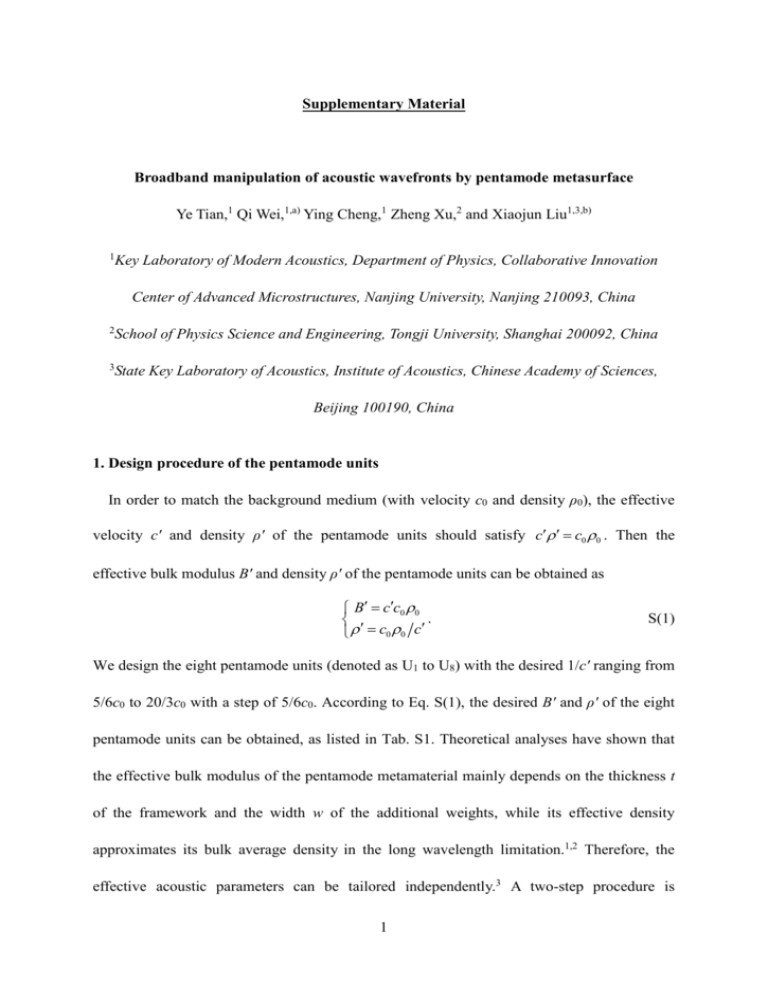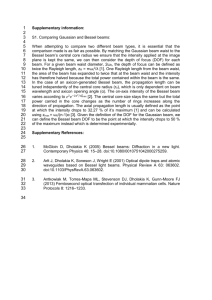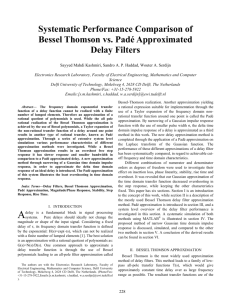Supplementary Material
advertisement

Supplementary Material Broadband manipulation of acoustic wavefronts by pentamode metasurface Ye Tian,1 Qi Wei,1,a) Ying Cheng,1 Zheng Xu,2 and Xiaojun Liu1,3,b) 1 Key Laboratory of Modern Acoustics, Department of Physics, Collaborative Innovation Center of Advanced Microstructures, Nanjing University, Nanjing 210093, China 2 School of Physics Science and Engineering, Tongji University, Shanghai 200092, China 3 State Key Laboratory of Acoustics, Institute of Acoustics, Chinese Academy of Sciences, Beijing 100190, China 1. Design procedure of the pentamode units In order to match the background medium (with velocity c0 and density ρ0), the effective velocity c′ and density ρ′ of the pentamode units should satisfy c c0 0 . Then the effective bulk modulus B′ and density ρ′ of the pentamode units can be obtained as B cc0 0 . c0 0 c S(1) We design the eight pentamode units (denoted as U1 to U8) with the desired 1/c′ ranging from 5/6c0 to 20/3c0 with a step of 5/6c0. According to Eq. S(1), the desired B′ and ρ′ of the eight pentamode units can be obtained, as listed in Tab. S1. Theoretical analyses have shown that the effective bulk modulus of the pentamode metamaterial mainly depends on the thickness t of the framework and the width w of the additional weights, while its effective density approximates its bulk average density in the long wavelength limitation.1,2 Therefore, the effective acoustic parameters can be tailored independently.3 A two-step procedure is 1 considered to design the eight units based on the finite element method (FEM). Firstly, we adjust t and w to make the effective bulk modulus equal to its desired value. Secondly, we adjust h to ensure the effective density equaling to its desired value. Figure S1 gives the schematic diagram of the eight designed pentamode units, and the geometric parameters are listed in Tab. S2. The units U1 and U2 are made of aluminum while the other six units are made of lead. TAB. S1. Desired acoustic parameters of the eight pentamode units. Unit U1 U2 U3 U4 U5 U6 U7 U8 1/c′ 5/6c0 5/3c0 5/2c0 10/3c0 25/6c0 5/c0 35/6c0 20/3c0 B′ 6ρ0c02/5 3ρ0c02/5 2ρ0c02/5 3ρ0c02/10 6ρ0c02/25 ρ0c02/5 6ρ0c02/35 3ρ0c02/20 ρ′ 5ρ0/6 5ρ0/3 5ρ0/2 10ρ0/3 25ρ0/6 5ρ0 35ρ0/6 20ρ0/3 FIG. S1. Schematic diagram of the eight pentamode units. TAB. S2. Geometric parameters of the eight pentamode units. Unit U1 U2 U3 U4 U5 U6 U7 U8 t (mm) 0.540 0.183 0.613 0.441 0.330 0.195 0.137 0.105 w (mm) 1.5 3.0 1.0 1.5 2.0 3.0 3.5 3.8 2 h (mm) 2.95 6.08 2.58 4.18 4.89 5.08 5.47 5.85 2. Band structures of the pentamode units Based on the FEM, we calculate the dispersion curves of the eight pentamode units, which are shown in Figs. S2(a)-S2(h). The first and second branches emerging from the Γ point are the dispersions of the shear and compression waves, respectively. The slopes of the branches correspond to the phase velocities. The ratios of the effective shear modulus to bulk modulus are about 0.028, 0.0078, 0.028, 0.018, 0.013, 0.0091, 0.0065 and 0.0050, resulting in the low coupling between the shear and compression waves for all units. Thus, the units can actually behave as pentamode materials. The slopes around the Γ point in the ΓJ and ΓX directions are almost the same, indicating the isotropic property for the pentamode units. Besides, the second branches are approximately straight, resulting in nearly constant phase velocities for the compression waves over the entire investigated frequency range, which is desirable for the construction of the proposed broadband metasurface. FIG. S2. [(a)-(h)] The dispersion curves of the eight pentamode units in the first Brillouin zone, along the ΓJX path. 3 3. Construction procedure of the pentamode metasurface As described by Eqs. (3) [ 1 c( x) (1 lc0 ) sin t ( x)dx ] and (4) [ ( x) 0 c0 c( x) ], the ideal metasurface has continuous profiles for velocity and density, which can be approximated by a pentamode metasurface with discrete profiles for velocity and density. The pentamode metasurface is constructed by using the eight pentamode units under the rule of minimizing |1 c( x) 1 c | . For example, the section of the ideal metasurface where 5 6c0 5 12c0 1 c( x) 5 6c0 5 12c0 is constructed by the unit U1 since the reciprocal of the effective velocity ( 1 c ) of U1 is 5/6c0. Figures S3(a)-S3(c) show the design schematics of the pentamode metasurface for the cases of anomalous refraction, Bessel beam generation and flat lens, respectively. According to Eq. (2) [ sin t ( x) lc0 d [1 c( x)] dx ], the refraction angle is proportional to the thickness l of the metasurface and the gradient of the velocity, but the designed units provide only finite eight velocities. Hence we employ three layers of pentamode units ( l 3a ) to enlarge the manipulation range of the refraction angle. The vertexes of the hexagons of adjacent layers are not connected and the gaps between the adjacent layers are filled with the background medium. It is noted that the thickness of the metasurface ( l 3 20 ) is still sub-wavelength and the energy transmittance is greater than 95% over the entire investigated bandwidth. The major challenge for experimental validations stems from the fabrication of the pentamode metamaterials. The proposed pentamode units have small geometric size and their effective acoustic parameters are sensitive to the machining precision. For example, the thickness of the metal framework is only 0.105 mm for Unit 8, as shown in Fig. S1(a) and Tab. S2. The pentamode units may be fabricated by the advanced 3D metal printing technology. 4 FIG. S3. Design schematics of the pentamode metasurface for the cases of (a) anomalous refraction, (b) Bessel beam generation and (c) flat lens. The total numbers of the pentamode units for the three cases are 267, 1053 and 459, respectively. 5 4. Contrast between the Bessel beam generation and the flat lens FIG. S4. Pressure field distributions for [(a), (b)] Bessel beam generation and [(c), (d)] flat lens under normal incidence at [(a), (c)] ka = π/16 and [(b), (d)] ka = π/10. Figures S4 and S5 show the pressure field distributions and the cross-section intensity profiles for the Bessel beam generation and flat lens. For the case of Bessel beam generation, it is found in Figs. S4(a) and S4(b) that the transmitted waves are focused in the area which is similar to the theoretical Bessel formation zone (drawn in red lines), and the transmitted waves resist diffraction in a relatively long distance at both frequencies. Figure S5(a) indicates a strong intensity for the transmitted beams along the y-axis. Figures S5(b) and S5(c) 6 show that the transverse profiles of the intensity fields are all Bessel-like, which almost stay at different distances. The results demonstrate the well Bessel-beam generation. For the case of flat lens, it is found in Figs. S4(c) and S4(d) that the transmitted waves are focused on the focal point. Figures S5(d)-S5(f) show that the intensities are strong at the focal point. However, the intensities decrease significantly with the locations away from the focal point. The results confirm the excellent broadband focusing effect. Overall, the transmitted energy is focused in a diamond area and the transmitted beams resist diffraction for the case of Bessel beam generation, while the transmitted energy is focused on a point for the case of flat lens. Therefore, we can clearly distinguish the case of flat lens from that of Bessel beam generation based on the results in Figs. S4 and S5. FIG. S5. (a) Intensity profiles along the axial direction (x = 0) for the case of Bessel beam generation at ka = π/16 (black dashed line) and ka = π/10 (red solid line), respectively. Intensity profiles along the transverse direction at y = 400a (black solid line), y = 500a (red dashed line) and y = 600a (blue dot-dashed line) for the case of Bessel beam generation at (b) 7 ka = π/16 and (c) ka = π/10, respectively. (d) Intensity profiles along the axial direction (x = 0) for the case of flat lens at ka = π/16 (black dashed line) and ka = π/10 (red solid line), respectively. Intensity profiles along the transverse direction at y = 100a (black solid line), y = 200a (red dashed line) and y = 300a (blue dot-dashed line) for the case of flat lens at (e) ka = π/16 and (f) ka = π/10, respectively. 5. Effects induced by the losses FIG. S6. Pressure field distributions of anomalous refraction for (a) loss-free case, (b) low-loss case and (c) high-loss case at ka ~ π/10, respectively. Take the anomalous refraction as an example. We use the thermally conducting and viscous model instead of the ideal loss-free model in the FEM simulation, and the resulting pressure field distribution is plotted in Fig. S6(b). There is no remarkable difference in pressure field distributions between Figs. S6(b) and S6(a) (the ideal loss-free case). Since the working frequency (f = 5505.89 Hz) is low, the thermally conducting and viscous losses should be very low. We calculate the total transmitted energies and find out that the loss is smaller than 0.1%. Considering a possible high loss in experiment induced by other factors, 8 we also investigate the high-loss case for the metasurface by the FEM simulation. The resulting pressure field distribution is plotted in Fig. S6(c). It is found that the functionality of the metasurface remains the same although the transmittance is lower than that in the loss-free case, since the loss only weakens the amplitude but does not change the phase of the transmitted waves. References 1 A. N. Norris and A. J. Nagy, “Metal water: A metamaterial for acoustic cloaking,” in Proceedings of Phononics, Santa Fe, New Mexico, USA, May 29-June 2 2011, pp. 112–113. 2 A.-C. Hladky-Hennion, J. O. Vasseur, G. Haw, C. Croënne, L. Haumesser, and A. N. Norris, Appl. Phys. Lett. 102, 144103 (2013). 3 M. Kadic, T. Bückmann, R. Schittny, P. Gumbsch, and M. Wegener, Phys. Rev. Appl. 2, 054007 (2014). 9









